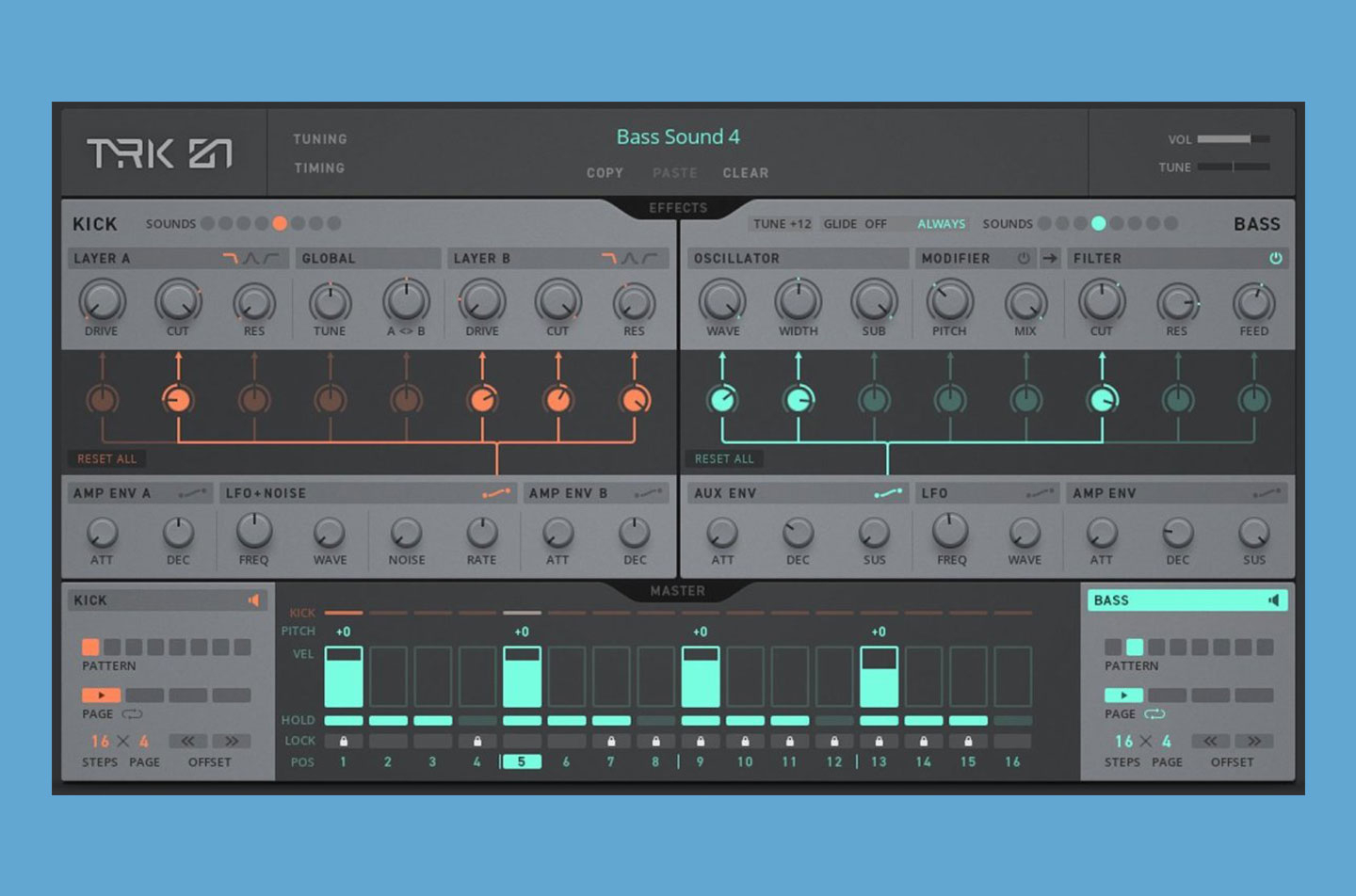- An all-in-one tool for balancing kicks with basslines.
- Ask anyone working in electronic music production and they'll tell you that one of the most onerous tasks is getting the kick and bass to work well together. This can involve surgical EQing, sidechain compression, pitch and tuning adjustments, and copious amounts of automation. What if there was an easier way of doing this? Native Instruments' latest offering, TRK-01, was designed to do just that, providing a means to generate and sequence kicks and basslines in a single instrument.
Like many of Native Instruments' recent synthesis-based instruments, TRK-01 was built using Reaktor 6. If you're not already an owner of the full version of Reaktor, you can run it inside of the free Reaktor 6 Player plug-in. This allows you to use all of the features of the instrument and to create and save your own presets. The only thing you can't do in Reaktor Player is open up the ensemble and tinker with the internal structure. As one would expect, TRK-01 has NKS support, which means you can also use it in Komplete Kontrol and Maschine with the benefit of pre-mapped controls, tagged preset searching and lightguide integration for the Kontrol S keyboard range.
TRK-01's UI is split into three main sections. The middle section is where you'll find the two sound engines, with the Kick on the left and the Bass on the right. Each has a set of tabs with knobs that provide quick access to the most essential controls, but additional parameters and visual feedback cues can be revealed in the central display area by clicking on the tab header. Furthermore, clicking the Effects label sitting between the two engines opens a separate page dedicated to the engines' effects. The bottom section, which houses two sequencers and the master effects modules, has a similar navigational paradigm where clicking the Master label switches between the two views. The UI has another trick up its sleeve when it comes to modulation routing, requiring you to click the little cable icons in the tab headers to set the modulation amounts. Little quirks like this may be a disadvantage to users who like to jump into a plug-in without reading the manual or watching videos, but after using it for a while, it all becomes fairly straightforward.
When it comes down to the business of actually making sound, TRK-01 has a surprisingly deep set of tools on offer. Starting with the Kick engine, you'll find two layers to work with, each with its own dedicated filter. Both layers offer a choice of four modes: sample, synth, rumble and noise. Sample mode provides a choice of 120 curated samples organised into familiar categories, the last of which (User) lets you load your own samples via drag and drop. Being able to load custom sounds is a great feature to have, as it opens up TRK-01 to more diverse purposes than would have been otherwise possible. The other modes use synthesiser algorithms tailored for making kick drums, low-frequency rumbles, high-frequency textures and noise. You can mix the two layers of the Kick engine with a crossfader that has its own detailed parameters for stereo width and fader curve. For modulation, the Kick engine provides two amp envelopes and an LFO with noise that can be configured to modulate the eight upper knobs.
The Bass engine design is very similar to its Kick counterpart. However, instead of two layers, you get a single oscillator module with five modes and a dedicated sub oscillator, as well as a filter module with more detailed options than those on the Kick side. The Bass oscillator modes include a classic dual oscillator architecture, supersaw, a wavefolding Buchla style mode, two-operator FM and a dual wavetable mode. The init patch does the Bass engine no justice, but with some tweaking and processing, you can get some very impressive tones out of TRK-01.
TRK-01 offers a few different ways of getting the kick and bass to work well together. In addition to common EQs and filters, both signals pass together through master effects that can both accentuate and tighten up the low end. More crucially however, the Bass engine has a dedicated ducking envelope, which can be assigned to modulate any of the engine's parameters with an envelope triggered by the Kick sequencer events. This is levels more powerful than a typical sidechain as you can have it doing multiple things at once. For example, you could adjust both volume and the low EQ band in differing amounts. Finally, there's an option in the tuning panel to lock the pitch of the kick to the root note of the bass sequence, which is an important technique in achieving a cohesive feel to a track.
The one big area where TRK-01's design choices left me scratching my head is its relatively closed nature. The sequencers for both the Kick and Bass engines are fairly deep, allowing for polyrhythmic pattern lengths, parameter locking and global transpose. But they are the only way to actually play the instrument. You can't just sit down at a keyboard and expect to audition sounds or even program sequences that way, as MIDI input to the plug-in is restricted to changing sound presets and patterns. Therefore, you're left with quite a bit of mouse clicking in order to program the patterns. This can be tedious, especially when trying to create melodic sequences that require separate values for pitch, velocity, hold and so on. As one would expect, this means there's also no way to export pattern MIDI for use in DAW arrangement. Another limiting factor is found in TRK-01's support for host automation, where many engine and effect parameters and, more importantly, the tuning panel controls are invisible to your DAW. With that in mind, it's probably more accurate to think of TRK-01 as a piece of hardware rather than a software instrument.
Ratings:
Cost: 4.2
Versatility: 3.5
Ease of use: 4.0
Sound: 4.8
